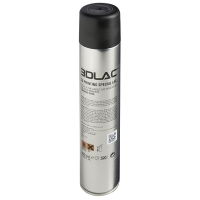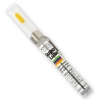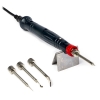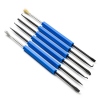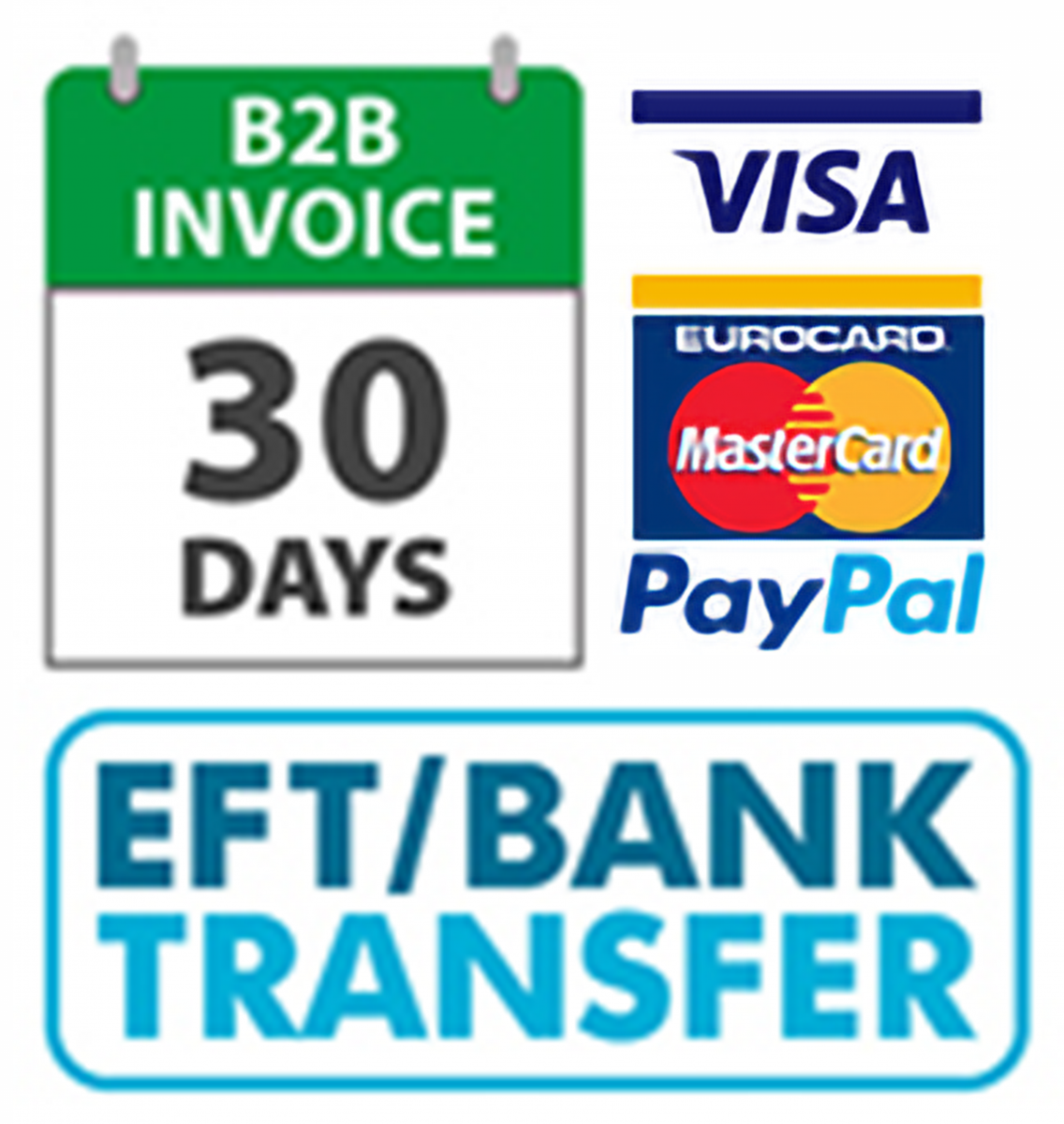Order high-quality 3D filament from well-known brands such as Polymaker, ColorFabb and Real Filament. To save money, without compromising on quality, try our own brand of filament. Our 123-3D filament is made in the EU and comes with a 100% guarantee.
What is 3D filament?
3D filament is the material used in 3D printing with FDM printers. It is used in conjunction with the 3D FDM printer, to create 3D physical objects. This works by building layer upon layer until the final object is created. The filament is supplied on a spool which is fed into the 3D printer and is extruded via a nozzle. The melted material is then cooled and solidified into the shape instructed. A spool generally contains 1kg of filament, roughly about 330m. Special filaments are often available in 0.5kg spools, and for uninterrupted mass printing, we have industry-scale spools that can contain 5kg+ of filament. 1.75mm filament is the standard size, while others like 2.85mm are used for specific applications.
Finding the right filament for your 3D printing job
There are many types of 3D filaments. The most popular and easy-to-use filament is PLA (Polylactic Acid), PLA is great for beginners, cheap and biodegradable. A commonly used more durable filament is PETG (Polyethylene Terephthalate Glycol). PETG is a strong plastic and so suits stronger builds, it is not so biodegradable. ABS (Acrylonitrile Butadiene Styrene) is a more flexible filament that is strong, durable and produces a shine effect. These filament types are favoured by beginners and experts alike. There are many other types of filaments which you can order here. Each type of filament has its own advantages and disadvantages and is suited to different print jobs.
Below is a handy table that will easily help you identify which type of filament to use, its characteristics and its applications for both household and industrial use.
| Filament Type |
Characteristics |
Household/Hobbyist Uses |
Industrial Uses |
| PLA |
Easy to print, rigid, biodegradable |
DIY projects, figurines, kitchen utensils, toys |
Prototyping, architectural models, packaging |
| ABS |
Durable, impact-resistant, post-processable |
Functional prototypes, parts, storage containers |
Automotive parts, casings, machinery components |
| PETG |
Strong, flexible, chemical-resistant |
Food storage containers, phone cases |
Medical equipment, signage, display fixtures |
|
TPU (flex)
|
Flexible, elastic, rubber-like properties |
Shoe soles, phone cases, wearable accessories |
Grips, seals, gaskets, flexible connectors |
| Nylon |
Strong, durable, low friction |
Mechanical parts, hinges, gears |
Automotive components, aerospace parts, industrial tools |
| PVA |
Water-soluble support materia |
Dissolvable support material for complex prints like figurines |
Complex structures, intricate models |
| HIPS |
Dissolvable support material |
Dissolvable support material for complex prints like figurines |
Prototyping, packaging, low-cost models |
| PC |
Heat-resistant,strong,transparent |
Light fixtures, safety goggles, transparent parts |
Electrical components, automotive parts, medical devices |
| PEEK |
High-temperature resistant, strong |
Aerospace components, automotive parts |
Aerospace components, industrial machinery parts |
| PEI (Ultem) |
High-temperature Resistant, chemical-resistant |
Electrical connectors, medical devices |
Aerospace components, electronics, automotive parts |
Find out more about filament types on our
3D filament information page.
Some more factors to consider when choosing 3D filament
Once you have chosen the filament material type and identified its properties, there are a few more factors to consider listed below.
-
Size of filament- Filament spools come in two different thicknesses. The most commonly used 3D filaments are 1.75mm in diameter. There are thicker filaments that are 2.85mm in size. Not all 3D printers are designed to fit 2.85mm filament spools, so it’s important to check the specifications of your specific 3D printer model. Using a filament diameter that is not supported by your printer can lead to feeding issues, extrusion problems, and inconsistent prints.
-
The brand you’d like to work with is another factor. We stock many well-known 3D printing filaments such as REAL, Polymaker, ColorFabb and more.
-
In addition, we stock our own brand of 123-3D filament which has been tested to stand up to the quality of the most popular brands whilst offering you savings when it comes to price.
-
If you’d like to search by your 3D printer brand or specific 3D printer model, you can do so easily. This will provide you with all the filament types and sizes that will work perfectly in your printer, eliminating confusion.
- Colour is another important choice to consider. We have a huge variety of colour shades to suit all projects including popular colours such as black, grey, white, red, blue, green and more. We also have some less common colours such as rainbow, glow-in-the-dark filament, chameleon, bronze, gold and more.
- If you’d like to dye your own filament, we have PLA pellets in stock for great prices.
As you can see, there are plenty of factors to consider. If you are an experienced 3D printer, you might want to test different types of filament to find the optimal one for exactly what you are going to print.
When would I need heat-resistant filament?
Heat-resistant filaments like PETG, PEEK, or PEI are suitable for creating objects that withstand high temperatures. An example of household use would be for kitchen or oven accessories, lampshades or lighting fixtures that would be required to withstand heat. Some example of industrial use that requires heat-resistant filament includes prototypes for automotive parts, engine components, industrial machinery, heating or lighting systems, as well as aerospace applications.
When would I need flexible filament?
Flexible filament, also known as TPU (Thermoplastic Polyurethane), is popular for projects that require parts or objects with flexible and elastic properties. Some beginner-friendly uses include ergonomic handles for tools, jewellery or other artistic designs, and wearable designs such as bracelets, watch bands or phone cases. In terms of industrial use, flexible filament is used in robotics and prosthetics, in mechanical or plumbing applications to ensure proper sealing and prevent leakage and in Medical and orthopaedic devices for the production of customisable braces, orthopaedic supports, or prosthetics. Read more about flexible filament here.
When would I need dissolvable filament?
Filament that can dissolve is particularly useful for creating complex prints that require support structures. Filaments like PVA allow you to dissolve the supports in water afterwards so that the finished product is clean. HIPS filament also dissolves by soaking the print in limonene. If your print requires overhangs, intricate details or inaccessible areas then materials that can dissolve afterwards are perfect without damaging the main printed object. dissolvable support materials like PVA or HIPS can be used alongside PLA or ABS to create complex prints with easily removable support structures.
Why choose 123-3D own-brand filaments
Our 123-3D filament is produced to a high-quality standard, no different from other well-known brands. On top of that, our filaments are cheaper than the other brands. We also offer a 100% satisfaction guarantee, if you are not satisfied, just contact our customer service team and they will solve any issues. The advantages of choosing our own filament are listed below:
-
Accommodates a wide range of printing temperatures. Print temperature precision is important to ensure optimal print quality and successful results. If the wrong temperature is used, it can cause issues.
-
One of the best filaments for beginners: Our filament has a diameter tolerance of 0.025% while others commonly have 0.05%. Filaments with smaller diameter tolerances generally exhibit more consistent printing behaviour and produce higher-quality prints.
-
Every type is made of high-quality material that is strong and durable
-
Comes in a large range of colours
-
Each coloured spool has consistent colour throughout the spool.
-
Delivered from our Dublin warehouse so no long waiting times!
-
Made locally in the EU
As you can see, there are many advantages to printing with 123-3D filament. Try for yourself today!
Useful products
Before you start your 3D print, it can be useful to use 3DLAC adhesive spray or Kapton tape to improve the adhesion of the filament to the printbed. Nozzles are essential components when it comes to 3D printing. They are responsible for depositing and shaping the melted filament material onto the print bed. Some nozzle types and sizes are suited better to particular types of filament. After printing, it’d hands to have post-processing tools on hand to edit, fix or personalise your print. These include tools themselves such as pliers or tweezers, and finishing touches such as primers or paint to perfect your printed object.
Common questions
Where do I buy cheap 3D filament?
Buy affordable 3D filament with fast local delivery at 123-3D.ie. With a range of familiar brands and their own-brand range, you’re sure to find what you need for less. You can avail of a high-quality 123-3D filament bundle with 5kg of filament for a cheaper price. Order today for fast delivery.
Which 3D filament material should I use?
The material you choose depends on what you are going to 3D print. The most common filament is PLA. There are lots of different colours and types of PLA filament, such as Glow in the Dark, metal, wood, PLA pro and much more. PLA is a user-friendly filament and is therefore recommended for beginners.
How long does 1kg of 3D printer filament last?
How long 1kg of filament lasts depends on how often you are printing and what you are printing. It can last a few days or a few months. As a reference point, you can print somewhere between 90 (100% infill) and 335 (5% infill) calibration cubes. For a more precise projection, you can run your intended models through a slicer (free software) and it will estimate each model's filament usage for you.
If you have any questions in regard to 3D filament or anything queries at all, don’t hesitate to
get in touch!

